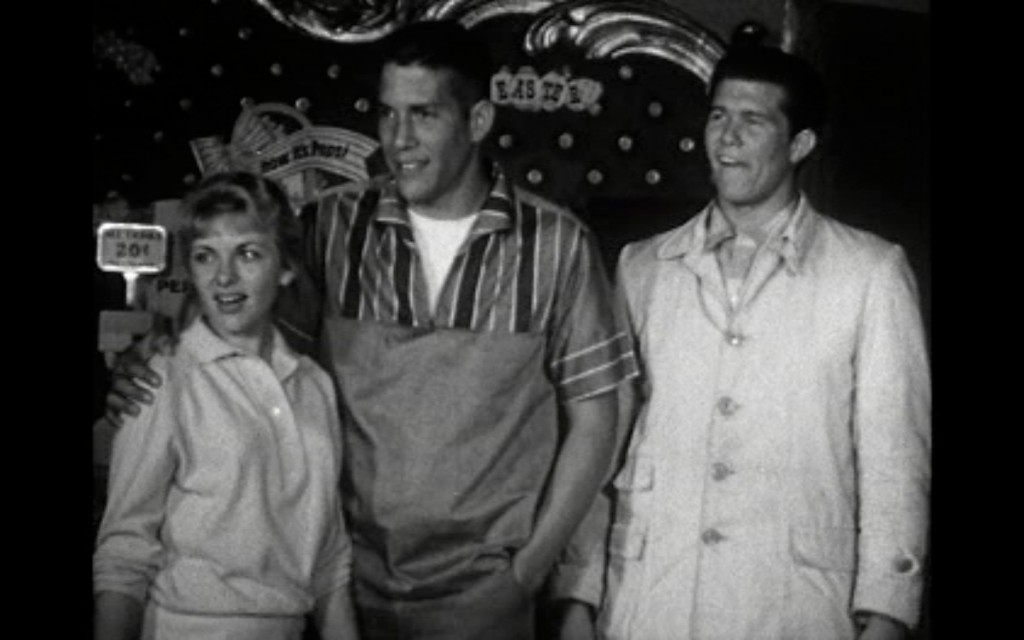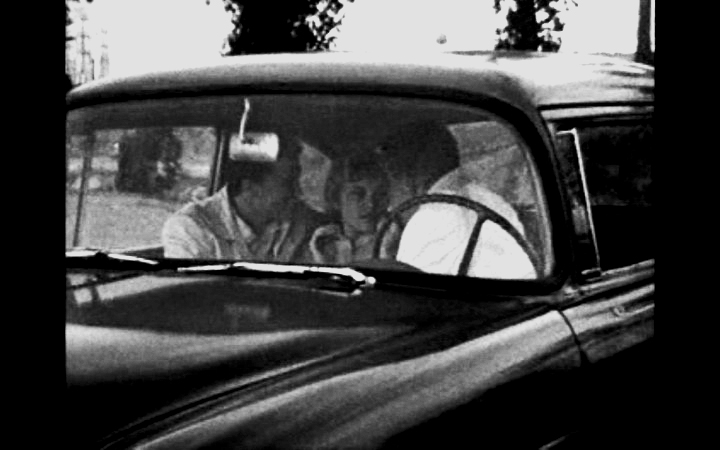Jen Baker’s recent blog post provides an excellent overview of the “stranger danger” films that were widely produced and disseminated in the postwar United States and England. Her analysis rightly concludes that such films encouraged “society to normalise the family as a haven from danger” and to ignore how “often the threat begins in the home” or comes from “friends or family.”

Baker’s analysis misses the mark, however, when she uses Sid Davis’ 1949 piece, “The Dangerous Stranger,” to claim that stranger danger films made in the United States between 1960 and 1980 coded sexuality so that it was legible to adults but inscrutable to child audiences because the threat “is never explicitly explained to the intended child viewers.” In fact, after 1957, these films explicitly named sexual danger. By using a 1949 film to characterize the productions of the three succeeding decades, moreover, Baker misunderstands key transformations to the genre.
The sexual content of stranger danger films grew more sexually explicit over time. In 1957, when the Supreme Court decided Roth v. United States, it liberalized obscenity laws and enabled a wider array of sexual representations in print, television and film. After Roth, didactic filmmakers such as Sid Davis became increasingly explicit even as they disavowed the sexual transformations that they portrayed. This growing overtness, as historian Beth Bailey notes, was a crucial facet of the sexual revolution.
While none of Davis’ films are as visually graphic as The Child Molester (1964), which shows actual police footage of murdered girls, there is nonetheless a move away from the innuendo of pre-Roth films and an increasing directness about sexual matters. For example, Davis’ stranger danger films, Boys Beware (1961) and Girls Beware (1961) and their remakes, Boys Aware (1973) and Girls Aware (1973), clearly convey the sexual threat of aggressive strangers, child molesters or homosexuals.
Because the intended audience of social guidance films was middle school and high school students (and their teachers), these films had to walk a fine line between educational and lurid. As a result, the films remained visually inexplicit. The narration, on the other hand, became the source of the most graphic sexual information. The narrator of Boys Beware, for example, explains that the consequences of interacting with homosexuals were dire; one could become a homosexual or be murdered by a homosexual. He further describes homosexuality as a “sickness that was not visible like smallpox but no less dangerous and contagious, a sickness of the mind.” Girls Beware portrays molestation in a similar way and also warns of gang rape and unwed pregnancy.
The films all emphasize that behind the veneer of postwar normalcy lay the possibility of contagion, corruption and violence from white males who lurked in playgrounds, public restrooms and schools or drove through quiet racially segregated suburban neighborhoods seeking to abduct and molest children. Strangers, like domestic communists or homosexuals, were an internal threat that could not be readily detected. (Significantly, when Davis remade Boys Beware in the 1970s, he shifted from an all-white cast to a mixed-race cast. This change suggests the changing racial politics of representation. However, sexual violence is carefully portrayed as intra- rather than inter-racial.)

The increased sexual directness is also apparent when comparing two of Sid Davis’ anti-drug films that bookend the 1957 Roth decision: The Terrible Truth (1951), and his updated version of the same film, Seduction of the Innocent (1961). Admittedly, these are not stranger danger films. However, they offer context for how Davis, one of the most prolific makers of social guidance and stranger danger films, shifted with and reacted to the sexual revolution.
Davis made his social guidance films in collaboration with police departments, psychologists and educators. In the 1960s and 1970s, his films conveyed many of these institutions’ anxiety over an inability to shape youths’ behavior and values. Tellingly, young people are seen but nowhere heard in most of Davis’ films. The archive is silent on how young people responded to this didactic fare. However, in the very act of making these videos, Davis and his collaborators conceded that youth were autonomous if not rebellious and therefore capable of choosing to obey or disobey adult rules.
Sexualized child protection rhetoric, which characterized stranger danger films, was an important conservative impulse in the 1950s and 1960s. It is therefore important to read these films against the backdrop of the generation gap and the sexual revolution. Doing so positions Davis and his colleagues, not as having the last word on sexual values, but as attempting to preserve a set of ideals that were already crumbling under the strains of the generational conflicts of the postwar era.
Gillian Frank is a Visiting Fellow at Center for the Study of Religion at Princeton University. Gillian’s research focuses on the intersections of sexuality, race, childhood and religion in the twentieth-century United States. He is currently revising a book manuscript titled Save Our Children: Sexual Politics and Cultural Conservatism in the United States, 1965-1990.

NOTCHES: (re)marks on the history of sexuality is licensed under a Creative Commons Attribution-NonCommercial-NoDerivatives 4.0 International License.
Based on a work at www.notchesblog.com.
For permission to publish any NOTCHES post in whole or in part please contact the editors at NotchesBlog@gmail.com






Pingback: “Stranger Danger”: the Public Service film and the protection of Child Sexuality | Notches: (re)marks on the history of sexuality
Hi Gill, thanks for the post, it is really helpful to be pointed toward the anti-drug films. I suppose my only “counter” would be that I was suggesting that the actual film Stranger Danger, like the British “Strangers” are creating a type of stranger and speaking explicitly to the younger child, the pre-pubescent, and those two clips do so without overt sexualisation. The Child Molester is however not intended for children, but the parents, so the visually graphic content and the directness is still not intended to educate the child, it is up to the parent to fill in the gaps, like those who “realised it was necessary to give Cathy specific information about child molesters – people with perverted minds who enjoy touching young children” – so here the parent needs to explain what it means to “molest” what is “perverse” and what exactly is meant by “touching” which could mean simply placing a hand on an arm.
I talk separately about older children (specifically) the Boys Beware and the homosexual stranger in a post to be published in the future; this first post was intended to be about the younger, prepubescent child and the stranger danger film – and how these clips (which were particularly well-known) dealt with that. I had not however, made this clear, and will amended accordingly or reference in the later post. However, I must concede that my scope was too wide and didn’t chart the changes, but also invited others and myself to do so. I found your post extremely interesting – always learning!
Hi Jen,
Thanks for your post and for your thoughtful response. It’s great to dialogue with someone else who is engaged with this set of texts.
Above, you use words like “older” and “younger” to modify the word “children” and in order to specify the intended audiences for these films. These qualifiers are important because they underscore the elasticity, diversity and dynamism of the category of “the child” (which historians continually need to spotlight). Still, I am very cautious about making claims about the age of the films’ audiences. I have yet to find evidence that tells me how these films actually circulated and who viewed them in the United States. Likewise, I have yet to discover sources that reveals the responses of young people to these films. Have you found corroborating sources that specify the age ranges of the audiences and how and where these films were distributed? I would love to know more about Sid Davis in particular and the ways in which his films were used!
Hi Gill, I haven’t found evidence of age ranges, when and where distribution took place – I think this may involve more than the internet can offer me – but a definite project for a later date! So if I remember in my long list of “hopeful projects for the future” I will get back in touch and see if we can liaise on Anglo-American contrasts and points of correspondence! However, I know that Charley films were broadcast on television pre-watershed and so were intended for the family, and some of the British stranger dangers from the 1970s and 80s do mention that they were shown in “junior” schools (so ages 8-12) a very interesting demographic, and although not yet corroborated by the statistical evidence – offers some initial interesting thoughts on the difference between language and imagery used for potentially different “intended” age-ranges…I saw a programme only the other day that looked at how Pornography today is accessed by children (they included age ranges and interviews) and a sex educator visited pre-school children and spoke about “pornography” (or rather indecent images) and explained that still in the UK this is only performed in a minority of schools – but I notice it was advocated in the Child Molester video.
Yes of course you are right, and I know this from my current (main) research on the monstrous child, that the complexities of definition (as created by socio-historic conditions, religion, law, medicine etc) are something to always be confronted before beginning any commentary (I start to -wrongly – assume that everyone will perform the same vetting and consider the same issues I do).
An interesting interchange between researchers Baker and Frank. In my own work some years ago (Sonenschein, Pedophiles on Parade, 1998), many of these films were not available to me and I appreciate the discussion. I look forward to seeing more detailed, and hopefully, a more critical approach by the two of you and others. There is considerable overlap between the American and British developments in the evolution of child saving, particularly during the Reagan-Thatcher eras, during which the contemporary child sex abuse hysteria took form. It will be good to see a mutual cross-cultural analysis.
The sense that such constructs as “the child” and “the molester” (now morphed into “the pedophile”) are tied to quite a number of parallel cultural streams is basically correct I think. To trace these out, one should be very wary of such obsolete shorthand expressions as “sexual revolution”, “homosexuality”, and of course, “child sexual abuse.” These are terms of popular navigation and positioning, and deserve, especially after this great length of time, a substantial investigative distance.
Estelle Freedman’s 1987 article “Uncontrolled Desires” offers some great insights into the stranger danger / sexual psychopath narrative of the postwar era. Also worth pointing out how the ‘protect our children’ approach was so heavily targeted at preserving the dichotomy of good girl / bad girl, with the good girl at a dangerous tipping point with her boyfriend that ultimately brings her to the attention of the stranger.
Thanks, Rebecca, for these comments. Freedman’s wonderful piece is very important and informs my own research. You’re right to note that these didactic films (which include but are not limited to the so-called ‘stranger-danger’ genre) were gendered and created good/bad girl dichotomies. I would add that much of the fare directed young women to channel their sexual behavior to steady relationships that would anticipate or lead to marriage. See for example, https://archive.org/details/HowMuchA1958
Looking forward to reading your forthcoming book.